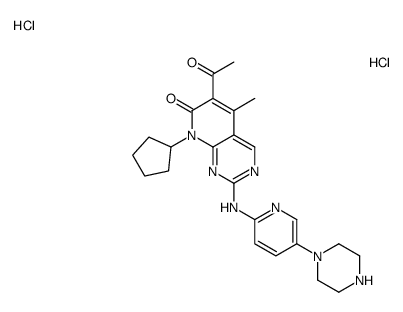571189-11-2
| Name | 6-acetyl-8-cyclopentyl-5-methyl-2-[(5-piperazin-1-ylpyridin-2-yl)amino]pyrido[2,3-d]pyrimidin-7-one,dihydrochloride |
|---|
| Description | Palbociclib (PD 0332991) hydrochloride is an orally active selective CDK4 and CDK6 inhibitor with IC50 values of 11 and 16 nM, respectively. Palbociclib hydrochloride has potent anti-proliferative activity and induces cell cycle arrest in cancer cells. Palbociclib hydrochloride can be used in the research of HR-positive and HER2-negative breast cancer and hepatocellular carcinoma[1][3][4]. |
|---|---|
| Related Catalog | |
| Target |
DYRK1A:2000 nM (IC50) MAPK:8000 nM (IC50) Cdk4/cyclin D3:9 nM (IC50) Cdk4/cyclin D1:11 nM (IC50) Cdk6/cyclin D2:16 nM (IC50) |
| In Vitro | Palbociclib (0-1 μM, 24 h) hydrochloride inhibits retinoblastoma phosphorylation at Ser795 in MDA-MB-435 cells with an IC50 value of 0.063 μM, and obtains similar effects on both Ser780 and Ser795 phosphorylation in the Colo-205 colon carcinoma[1]. Palbociclib (0-10 μM, 24 h) hydrochloride arrests MDA-MB-453 cells exclusively in G1 phase[1]. Palbociclib (500 nM, 7 days) hydrochloride increases expression of homologous genes (H2d1, H2k1, and B2m) in MDA-MB-453 and MDA-MB-361 cells[2]. Palbociclib (0-1 μM, 6 days) hydrochloride inhibits growth of several luminal ER-positive as well as HER2-amplified breast cancer cell lines, with IC50 values ranging from 4 nM to 1 μM[3]. Palbociclib (0-1 μM, 3 days) hydrochloride inhibits the proliferation of human liver cancer cell lines with IC50 values ranging from 0.01 μM to 3.49 μM, and induces a reversible cell cycle arrest[4]. Cell Proliferation Assay[3] Cell Line: ER-positive as well as HER2-amplified breast cancer cell lines (MDA-MB-175, ZR-75-30, CAMA-1, etc.) Concentration: 0-1 μM Incubation Time: 6 days Result: Inhibited growth of luminal ER-positive as well as HER2-amplified breast cancer cell lines. Cell Cycle Analysissup>[1] Cell Line: MDA-MB-453 cells Concentration: 0-1 μM Incubation Time: 24 h Result: Arrested MDA-MB-453 cells in G1. |
| In Vivo | Palbociclib (oral adminstration, 75 or 150 mg/kg, daily for 14 days) hydrochloride produces rapid tumor regressions and delays tumor growth[1]. Palbociclib (oral adminstration, 90 mg/kg, daily for 12 days) hydrochloride reduces Treg numbers and the Treg:CD8 ratio in the spleen and lymph nodes in tumor-free mice, demonstrating the tumor-independent effects[2]. Palbociclib (oral administration, 100 mg/kg, daily for 1 week) hydrochloride has potent antitumour effects in genetically engineered mosaic mouse model of liver cancer[4]. Animal Model: Mice bearing Colo-205 colon carcinoma xenografts (p16 deleted)[1] Dosage: 75, 150 mg/kg Administration: Oral administration; daily for 14 days Result: Produced rapid tumor regressions and a corresponding tumor growth delay of ~50 days. Animal Model: Tumor-free female FVB mice[2] Dosage: 90 mg/kg Administration: Oral administration; daily for 12 days Result: Reduced total thymic mass and immature CD4+ and CD8+ double-positive thymocytes, and increased the fractions of CD4+ and CD8+ single-positive thymocytes. Animal Model: Genetically engineered mosaic mouse model of liver cancer (Myc;p53-sgRNA)[4] Dosage: 100 mg/kg Administration: Oral administration; daily for 1 week Result: Decreased the luminescence signal in liver and delayed tumour growth. |
| Molecular Formula | C24H31Cl2N7O2 |
|---|---|
| Molecular Weight | 520.45500 |
| Exact Mass | 519.19200 |
| PSA | 105.04000 |
| LogP | 5.03660 |
